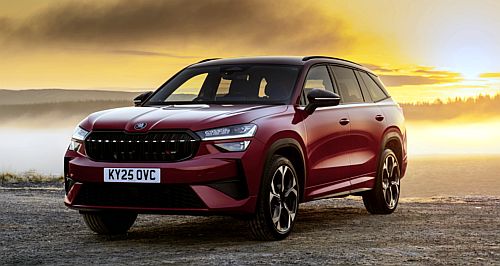Make / Model Search
News - SkodaSkoda's new boss details plan to double salesNew Skoda strategy coincides with arrival of reputed fixer Lucie Kuhn as brand director31 Mar 2025 By TOM BAKER A CIRCUIT-BREAKING brand recovery strategy has been enacted to boost Czech manufacturer Škoda’s sales performance in Australia, following a precipitous 37 per cent decline in deliveries in 2024 by the value-conscious marque.
Pricing, product, marketing, new hybrid engines, trim mix, fleet sales, total cost of ownership, and even ethical considerations will all factor into Škoda’s new Australian strategy, which is set to be implemented under the supervision of a well-regarded new leader.
The shake-up began last month with the arrival of new brand director Lucie Kuhn, whose appointment was announced in November.
Ms Kuhn has developed a reputation within the Volkswagen Group (VAG) as a key fixer for Czechia-based Škoda, with her 20-year VAG career most recently focused on managing growth markets in Southern Europe.
A Czech native, Ms Kuhn took the reins six weeks ago from caretaker director Kieran Merrigan and directly replaces long-serving leader Michael Irmer, who served as Škoda Australia’s brand director from 2013 to 2024. Mr Merrigan has returned to his role as head of product and marketing.
With experience building Škoda volume in Germany, Bosnia, and Albania, Ms Kuhn has been dispatched by Mladá Boleslav to lead a multifaceted strategy aimed at boosting the brand’s appeal in an Australian market defined by high living costs and growing competition – particularly from new Chinese entrants.
Few stones will be left unturned at Škoda Australia as the brand seeks to stabilise its sales performance and strengthen its foundations ahead of its 20th anniversary in 2027—the year Ms Kuhn believes the marque’s long-held goal of 10,000 annual sales in Australia is realistically achievable.
Speaking with GoAuto at the launch of the critical second-generation Škoda Kodiaq three-row SUV in Bendigo, Victoria, Ms Kuhn was candid about the brand’s commercial performance in Australia.
“We have been in Australia for 18 years. We have a solid car count here in the country – over 80,000 units,” Ms Kuhn said. “We have a base that we can build on.
“We must very simply increase sales. In the past, we were on a good track. We were close to 10,000 units (in a year), which is a number I would say suits the Skoda brand pretty well. Then it dropped to a certain level that I would call unsatisfactory.”
While last year’s 37 per cent delivery decline (from 7999 to 5015 units) was concerning, Škoda’s local performance has been turbulent for over a decade, with sales figures marked by sharp swings.
The arrival of a portfolio of SUVs in the late 2010s saw sales climb from 4750 in 2015 to a record high of 9185 units in 2021, before slipping to 6502 in 2022.
All VAG brands sold in Australia – except for Porsche – recorded lower deliveries in 2024. Spanish upstart Cupra fared even worse, with a 38 per cent year-on-year drop.
However, Škoda’s more established local presence is understood to have contributed to a decision to shift strategy more assertively.
“There were reasons (for the sales decline),” Ms Kuhn explained. “During COVID times, we faced product restrictions and many car manufacturers developed higher prices. We lost a bit of momentum. Another reason was that our portfolio was relatively old.”
Ms Kuhn aims for a rapid turnaround and predicts for a respectable 20-30 per cent recovery in 2025 alone: “10,000 probably won’t be this year or next, but I think (in two or three years) it is really possible. For this year, we are running directions for 6000 to 6500 units”.
Škoda will be flush with new-generation and facelifted products in several key Australian market segments by the end of this year. The relatively early arrival of the second-generation Kodiaq large SUV (from $54,900 before on-road costs) gives the brand fresh metal to market to its core demographic of cost-conscious families.
“Our brand customer group always used to be families. Now, with energy prices and living costs being significantly higher, it is our aim to get them back. The families that were with us have grown up, and we are not gaining new families – I think we have something to offer them in Kodiaq,” said Ms Kuhn.
Following the arrival of the new Kodiaq large SUV (and facelifted Octavia RS medium passenger car) this month, Škoda Australia will launch the Elroq midsize electric SUV in June, the fourth-generation Superb sedan and wagon in July, the facelifted Enyaq electric SUV in August, and a performance-oriented Kodiaq RS in September.
Most of those models are aimed at private buyers, but Ms Kuhn says she is also focused on increasing fleet sales. The new-generation Superb, in particular, is expected to attract police interest in the coming months.
While the launch calendar already includes a healthy mix of turbocharged internal combustion engine (ICE) and battery electric (BEV) powertrains, Škoda will also introduce mild hybrid and plug-in hybrid (PHEV) options locally – recognising that many buyers favour a transitional technology.
The Octavia is expected to gain a 110kW/250Nm 1.5-litre turbocharged mild-hybrid four-cylinder in September ahead of a 150kW plug-in hybrid for the Kodiaq and Superb lines.
Slated for summer 2025-2026, the PHEV grants “over 100km” electric range in the Kodiaq, and “up to 120km” in the slipperier Superb.
A renewed focus on sharp pricing – while maintaining strong value for money – will accompany the arrival of the new models. Škoda Australia and its Czech headquarters have acknowledged that the brand’s move upmarket locally has diluted its unique selling proposition.
“The reason customers buy Skoda is the quality and the premium feeling. These customers will always be valuable for us, but we are extending the portfolio to more basic models because we see that we cannot only stay with premium customers,” Ms Kuhn said.
“We should also target, and try to get, the customers that were with us in the past but are not with us anymore because (Skoda) cars have become too expensive.”
Škoda Australia product manager Glenn Reid explained that the brand is working to establish a consistent trim structure, with new ‘Select’ base models priced more sharply to re-engage value-focused buyers.
Premium customers will gravitate toward mid-tier Sportline and flagship RS variants, while luxury trim grades will occasionally be made available as special editions.
Škoda’s focus on weekly cost of ownership is set to intensify, recognising that around four in five Australian new car buyers finance their purchase.
“It is not just the purchase price,” product chief Kieran Merrigan told GoAuto. “It is more around what potentially (the customer) can get from a weekly or monthly payment perspective … with (guaranteed future) value protection and a fixed interest rate. There are massive benefits for a consumer looking to get value for money not just in the car but in the finance offer, as well.”
To that end, the Kodiaq will be offered to Australian buyers at launch with a fixed 7.99 per cent interest rate over a five-year finance term – significantly undercutting the typical rates available on rivals such as the Hyundai Santa Fe and Mazda CX-80.
Mr Merrigan is also spearheading a push to rein in Škoda Australia’s occasionally eccentric marketing, favouring a clearer emphasis on fundamentals like price, size, seat count, and European manufacturing in advertising.
“Clear messaging is super-important. It is a mission I have taken upon myself to try and tell people about. We have a super-high conversion rate (after a test drive) … We are always looking at ways we can adjust and strengthen our messaging to try and lift consideration.”
According to Ms Kuhn, future consideration will increasingly include ethical factors – especially as some new entrants to the Australian market struggle to provide transparency on supply chain integrity or fair pay and labour conditions.
“An asset (for Skoda) is the environment around our products. We have a clear history. We have high-quality testing based on strict legislative standards. Every part has a proven origin. We know where the part comes from, who was working with the part, and that we and our suppliers paid fair labour rates,” said Ms Kuhn.
“The customers, I believe, simply do not want to be connected with a brand that does not have a good public appearance, where you are not sure where the product comes from, or that it is 100 per cent safe and tested … I am quite sure (that) people feel it inside, that they want to have and own products that are not against their own (values) of being sustainable, and fair to others.”  Read more |
Click to shareSkoda articlesResearch Skoda Motor industry news |












Facebook Twitter Instagram